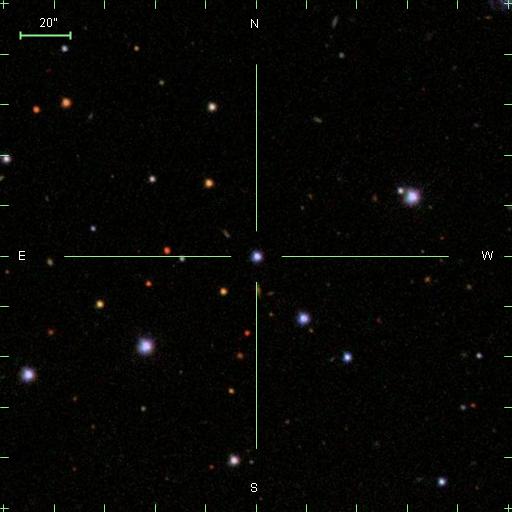







| BOOKS | F. A. Q. | ARTICLES | TALKS | ABOUT KEN | DONATE | BEYOND OUR KEN |
|---|
By Ken Croswell
Published on ScienceNOW (August 12, 2011)

Small star. Small planet? Credit: Sloan Digital Sky Survey.
A planet the size of Mars races toward a planet like Earth, smashes into its crust and mantle, and ejects debris that conglomerates into a large moon. Sound familiar? It's what scientists think happened billions of years ago to Earth. But the same drama may have unfolded much more recently around a nearby star in the constellation Hercules.
Known as NLTT 43806, the star is a white dwarf--a dim, dense, and dying sun about the size of Earth--located roughly 50 light-years away. "It is unique among known white dwarfs," says Benjamin Zuckerman, an astronomer at the University of California, Los Angeles. "Its surface has a very high aluminum abundance and a relatively low iron abundance."
That's strange, because most stars show the opposite pattern: much more iron than aluminum. Throughout the universe's life, stars have forged far more iron than aluminum, so iron nuclei normally outnumber aluminum by 10 to 1.
Where aluminum does abound is the outer layers of planets like Earth. It's the third most common element in Earth's crust, after oxygen and silicon. Iron, meanwhile, makes up most of Earth's core. In addition to aluminum and iron, Zuckerman's team discovered that NLTT 43806 contains seven other elements common in Earthlike planets. The researchers calculate that the relative abundances of all nine elements match what would turn up in a mixture of 30 percent terrestrial crust and 70 percent upper mantle.
"The most likely prospect is that there was a collision of two rocky objects in orbit around NLTT 43806," Zuckerman says. "One object hit the planet, knocking off some of its crust and outer mantle." After that material spewed into space, some fell onto the star, boosting its abundance of aluminum and other elements prevalent in the planet's crust and upper mantle. As Zuckerman and his colleagues will report in a future issue of The Astrophysical Journal, the collision likely resembled the one that produced the Moon and may even have given NLTT 43806's planet a large moon of its own. Furthermore, this collision probably occurred less than 50 million years ago--just the blink of an eye on a cosmic scale. That's about how long material from such a large impact should continue to rain down on the star, whose strong gravity quickly pulls the material beneath the surface and out of sight.
"Their observations are very well done," says astronomer Jay Holberg of the University of Arizona. "It all makes a very nice story, but in fact we don't really know what the source material is for what they've seen." The source may indeed have been debris from a moon-forming impact on an Earthlike planet, Holberg says, but less dramatic scenarios--such as an asteroid hitting the star--are also possible.
If the cosmic hit-and-run happened the way Zuckerman and colleagues suspect it did, the larger of the two planets involved should still be circling its star. Unfortunately, there's little hope of seeing the planet or of detecting the gravitational pull it exerts on NLTT 43806--let alone discerning whether the battered world has a newborn moon. Nevertheless, Zuckerman says the theory is testable, because it predicts how much potassium and manganese the star's surface has, something more sensitive observations should reveal in the future.
Ken Croswell earned his Ph.D. in astronomy from Harvard University and is the author of The Lives of Stars.
"A stellar picture of what we know or guess about those distant lights."--Kirkus. See all reviews of The Lives of Starshere.
| BOOKS | F. A. Q. | ARTICLES | TALKS | ABOUT KEN | DONATE | BEYOND OUR KEN |
|---|